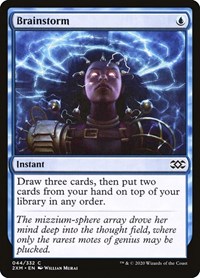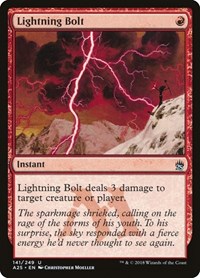Recently, Elizabeth Rice (@EllieoftheVeil) was telling me about a conversation she had about evaluating cards in which someone posed the hypothetical question of whether or not Oko, Thief of Crowns or Brainstorm would be the more powerful effect if introduced in to Modem.
At face value, this seems like an odd conversation to have, given that these cards serve completely different functions. Usually these discussions take a turn towards hyperbole, but the more I mulled over the question, the more I found myself interested in figuring out how to how to approach these sort of situations on how to evaluate and analyze cards.
At face value I think most people’s kneejerk response to this inquiry will be “one of these cards is restricted in Vintage while the other isn’t,” which, I think, is a somewhat fair, short-form response. But we can dive in a bit deeper, ya know?
Evaluating cards can be a dubious proposition of whose macro-frameworks to approach it from. When cards are analyzed objectively, we’re looking at their intrinsic power level. While when cards are viewed subjectively, we look at how they function within the framework of the format as well as the deck it’s being played in.
For example, in Legacy, Swords to Plowshares is viewed as the most powerful white spot removal spell. Even when you view it on more of an objective level, the card is too powerful to print into most modern day formats, which I assume lead to the printing of Path to Exile as a similar effect with a “higher” drawback to playing it. In most situations, giving your opponent an increase in life total is generally going to be less detrimental than giving your opponent a more tangible resource like a land. But what if we change the framework a bit? Then we can flip that dynamic.
In Legacy there’s a deck called “Nic Fit.” the name comes from an old thread on The Source, a now mostly defunct forum that used to be the central hub for Legacy discussions. A commenter stated that the synergy between Veteran Explorer and Cabal Therapy is a “Nice Fit.” It’s not uncommon for the Nic Fit shells that utilize white cards to play Path to Exile over Swords to Plowshares because once your deck already has a game plan centered around giving your opponent an excess of mana, an additional land or two is inconsequential.
So, while Swords to Plowshares is, in most cases, the better card, Path is functionally more potent in this context, at least at an overview level. As you go deeper, other factors come into consideration regarding playing around opposing Cabal Therapies, or the situations where you might want to Plow your own creature to gain life against Burn or similarly aggressive strategies.
(As an aside, if you’re interested in learning more about the history of Legacy, check out this article by Joe Dyer)
So, lets apply this framework to the Oko versus Brainstorm conversation. On an objective level, Oko is a much more powerful card than Brianstorm. It’s a self-contained engine that singlehandedly invalidates multiple angles of attack while also providing a constant stream of pressure on your end. By nature of also being an “army in a can,” Oko has a very high floor by comparison. Rather, that is to say that, in the situations where the card is the weakest, it still has a relatively high power level.
Conversely, Brainstorm’s power level is heavily contextual and, while still being a relatively powerful card at its base, it’s much weaker than Oko in a vacuum. This isn’t to say that Brainstorm isn’t a fairly strong card in its own right – it’s just to say that its relative power scales much more fluidly than Oko. For example, the presence of fetchlands or other low opportunity cost shuffle effects heavily effect how many copies of the card you’ll play in your deck.
For example, if you look at the blue decks in Legacy, you’ll see that it’s very rare for less than four copies of the aforementioned draw spell to be played.

Legacy Temur Delver by silviawataru
Creature (15)
Land (19)

Legacy BUG by Mussie99
Planeswalker (1)
Creature (11)
Instant (17)
Enchantment (3)
Land (21)
Whereas in Pauper, the card’s numbers are much more of a variable.

Pauper Dimir Delver by SambucoDeCulo
Sorcery (4)
Instant (23)

Pauper Wizard Blizzard by Osma Kass
Creature (20)
Sideboard (15)
This isn’t to say that Pauper decks can’t play the full set, but rather how many they play is often a variable based on on how easy it is for them to implement noninvasive shuffle effects into the decks construction.

Pauper Dimir Faeries by Beicodegeia
Creature (20)
Sorcery (4)
In conjunction with shuffle effects, Brainstorm has the potential to completely change the overall quality of your hand while the prevention of “Brainstorm Lock” circumvents having to redraw the undesirable effects you’ve placed on top of your deck. Due to this dynamic, when played “correctly,” Brainstorm starts to approach a point where it’s impact on games becomes analogous to Ancestral Recall.
So, Oko in a vacuum is, at face value, a more powerful card than Brainstorm. However, within the context of the formats that it sees play in, Brainstorm in application is a significantly more powerful effect.
It should also be noted that in order to play Brainstorm, you simply have to have Islands in your deck. This means that the opportunity cost of adding it to your deck is not only relatively low, but it seamlessly fits into any archetype. Aggro, combo, tempo, midrange or other shells don’t have to take many factors into account. On the other hand, with Oko, there’s some consideration to how he synergizes with the remaining cards in your deck.
Oko also has the additional restriction of being a multicolor three-mana value card which further acts as a limiting agent, making him ever so slightly less domineering over formats. What I mean is that players approach deck selection in a bevy of ways. Some go about it in a more objective sense while others choose decks based on what’s most fun for them to play.
Using Modern as an example, when Oko was legal, the shells that facilitated him were some of the the most powerful in the format, if not outright the most dominating archetypes. But even in the face of this, people still opted to try various non-Oko blue shells, which is indicative that the card was not integral to playing the format.
Hypothetically, if Brainstorm was integrated into Modern, there would not be the same sense of variety. Playing four copies of the card in every blue shell would ultimately be mandatory. This dynamic is what I find the frequent use of the term “strictly better” to be somewhat ignorant and needlessly hyperbolic. Cards aren’t played in vacuums; they’re played in within the context of a format and, due to the associated variables a card’s power level, will not only fluctuate from format to format, but also deck to deck.
For example, Lightning Bolt within the framework of Modern is a lock to be played as a four-of in shells like Burn or Delver while in less aggressive shells such as UWR Control or Jund, it’s not uncommon to see the cards numbers fluctuate.

Modern Jeskai Control by Benjamin Nikolich, SCG Modern Open Columbus 2018
Planeswalker (1)
Instant (23)
Enchantment (2)
Land (24)
So for instance, this UWR list plays a 3-3 split of Lightning Bolt and Lightning Helix. Which, when compared in a vacuum, Bolt is the “better” card due to the lack of restrictions to play it. Helix, similar to Oko, has the added opportunity cost of requiting additional support from the deck’s mana base by nature of having a more prohibitive casting cost. In context of the above deck list, Helix is weighed much more evenly with Bolt because of it’s ability to not only offset the fetch-plus-shock mana base, but also for being a main-deckable life gain effect that serves multiple functions.
This thought process lends itself to analyzing cards from a qualitative viewpoint. At face value, comparing Oko and Brainstorm seems like an odd and pointless exercise because the cards serve two completely different roles in deck building. You can’t compare apples and oranges right? Well… no, you can.
The flavor of the two fruits might not be comparable because they’re significantly different from each and favoritism of one or the other is contingent on personal biases. There are other metrics that you can utilize though, such as the mass of the fruit, how much juice can be garnished from it or the sugar content. For example, if you’re attempting to limit your sugar intake, oranges might be more appealing of an option at an average of 12 grams per fruit whereas apples contain a comparative 19 grams. This thought process can be applied to cards with seemingly different functions, so I’ll leave you all with a quick thought experiment to mull over.
Say you take the following formats: Vintage, Legacy, Modern, Pioneer, Historic and Standard and do an experiment where you make either Brainstorm or Oko legal. Which card would warp the most formats? How would they effect those format? What would the environment of Modern look like if (only) Brainstorm was legal compared to Modern where (only) Oko is legal?
One thing that I think is helpful when doing this exercise to use a line chart similar to the one below.

From here, you assign relative value to the scale and I think the most straight forward way to do so is as such:
10: Completely format warping, overwhelmingly dominating and ban worthy.
0: Inconsequential/no effect
-10: Unplayable and potentially a liability to utilize within the format as a whole.
While I’ve presented this concept within a macroanalysis of formats as a whole, it can also be used to compare individual effects as they operate within a deck of the observers choice.
10: Completely redefines the construction of a shell.
0: Inconsequential/no effect
-10: Unplayable and potentially a liability to utilize within this deck shell.
I think these exercises are not only fun, but a fruitful (no pun intended) way of maintaining a measured perspective on the power level of a card. So, are there any other non-analogous effects that come to mind that could be interesting to compare with this method? What about other vantage points in which card evaluation can be approached from?
Card analysis is a broad and complex topic and this discussion is only a drop in the ocean. I’d love to hear other peoples thought processes on how they approach card analysis, either in a comparative sense like this article or on an individual card by card level.









